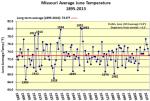COLUMBIA, Mo.—Missouri, with a rich heritage in milk production, is primed for dairy revitalization, says a University of Missouri Extension economist.
“Missouri has an advantage for milk production and an abundance of dairy infrastructure,” says Joe Horner.
Diary production and number of cows, farms and dairy farmers have declined for decades.
“That is changing,” Horner says. “Gains in Missouri milk production outpaced the national rate since 2013.”
But Missouri farmers just match consumer demand for fluid milk.
The MU dairy team has just released a “Missouri Dairy Industry Revitalization Study.” It was funded by the Missouri Agricultural and Small Business Development Authority in the Missouri Department of Agriculture.
The MU plan looks at sustaining existing producers, growing from within and attracting new producers. “There are many opportunities,” Horner says.
“To start revitalization we need to be all on the same page,” says Horner, who led the team. The study assesses current dairy and economic impacts, gives historical context, reports needs, and looks at economic potential. The study compares Missouri with other dairy states.
Manufacturers of cheese, ice cream, yogurt and other milk products employ more than 5,000 workers. They pay nearly $275 million in wages annually.
“Making more milk would keep jobs in Missouri,” Horner says. “It starts on the farm. Local cows provide fresher milk with lower hauling costs.”
Of Missouri farm products, milk is the one that creates an abundance of off-farm jobs, he says. That includes milk tankers, processing, distribution, milking equipment and refrigeration dealers, feed suppliers, and even record keepers.
When we stop and look, we see lots of dairy assets and advantages in Missouri, Horner says. On the downside, a demographic shift nears. Many lifelong dairy farmers are near retirement age.
For revitalization, Missouri needs more young producers, he says.
Most dairy farms are in southern Missouri. However, 98 of the 114 counties in the state have local dairy income.
“The economic impact of keeping dairy milkers and manufacturers in Missouri will be significant,” Horner says.
Missouri became a national leader in grass-based seasonal dairies, where cows harvest their own feed, Horner says. Lower input costs plus more time off appeals to new producers.
But many existing conventional dairy farms continue to expand.
While land prices seem high to Missouri farmers, out-of-state and even out-of-country farmers see land values as low.
Low-cost forages, whether corn silage or pasture grass, gives an economic edge. Low-cost corn and soybean byproducts are found across the state.
Prolonged drought in California and the Southwest leaves cows needing new homes, Horner says. “There are a lot of cows on the move.”
Missouri has water and favorable climate for dairying.
Historically, dairy farms gave a start to young farmers, especially returning GIs. The biweekly milk check helps sustain beginners.
The Missouri General Assembly passed and the governor signed a Missouri Dairy Revitalization Act of 2015. The popular bill was one of the first passed in the current session.
A feature of the bill when funded will be scholarships to students interested in dairying and returning to the business.
The report is on MU Extension’s Missouri Dairy Resources Guide at http://dairy.missouri.edu/revitalization.
Read more http://extension.missouri.edu/news/DisplayStory.aspx?N=2516





